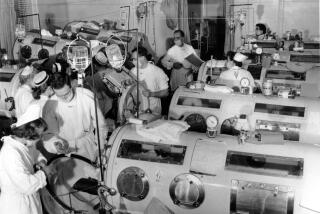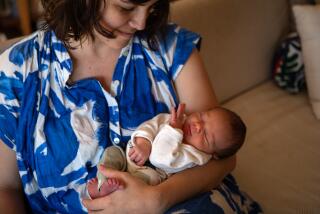Editorial: H1N1 Shot Hard to Prioritize
- Share via
With the unanticipated shortage of the new H1N1 swine flu vaccine, my life as a practicing internist suddenly changed. My office phone began ringing off the hook with worried calls. Fear of the new, unknown vaccine was suddenly replaced by fear of not having it.
This panic was overblown, as the H1N1 flu has been mild in the vast majority of cases.
I contacted the director of the Citywide Immunization Registry in New York, and by late October I was able to procure a small supply (100 doses) of both the inhaled live (but weakened) virus vaccine as well as the injected one made from dead virus. Though I wasn’t advertising it, word that I had it soon spread among my patients and friends.
Patients I hadn’t seen in years, who had been neglecting their overall health and resisting my office manager’s attempts to schedule them appointments, were suddenly leaving telephone messages demanding to come in. Friends and acquaintances whom I had never seen as patients began to bombard me with e-mails asking if they could have a shot or a whiff.
Meanwhile, I was doing my best to target those who are known to be most at risk for the pandemic H1N1 strain: pregnant women, children and those with chronic conditions.
But many of my patients were more self-preoccupied than that, expecting the vaccine just because they knew me, scheduling an appointment without a stated reason and then frantically demanding the vaccine as soon as they were through the door.
I engaged in heated debate with many of these patients and turned them down, trying to save my doses for those who needed them the most.
I was proud of the fact that, because of the continuing shortage everywhere, my office soon began to resemble a pediatrician’s or obstetrician’s office, with patients and associates coming in with pregnant bellies or bringing their little children, some crying from the fear of shots. My office nurse had experience working for a pediatrician and was glad to see my patient population suddenly turning younger. I gave the children the sniff if they were over 2 years old and didn’t have underlying medical conditions. I gave each one a tongue depressor as a souvenir, though they were probably expecting a lollipop.
Two weeks after receiving the vaccine, I had already given out half of it. There was still a big shortage nationwide and in New York, but I was beginning to give in to the pressure, providing doses to patients who needed it more than the average person but weren’t necessarily at the top of the list.
“John Matthews” -- not his real name -- had heart disease but was 64 years old, right at the upper limit of the Centers for Disease Control and Prevention guidelines of who I should vaccinate. An article published in the New England Journal of Medicine in the spring had suggested that older people were more likely to have partial immunity to the H1N1 strain causing the current pandemic, thought to be because of past exposure to a related flu virus that was circulating before 1957. Matthews would number in this group.
On the other hand, a study published in the British journal Lancet in September reminded me that influenza could be a trigger for a heart attack, especially in a susceptible patient like him.
I wasn’t sure whether to give him the vaccine. I couldn’t offer him the nasal version, because he was over 50 years old and it contained a live though attenuated -- weakened -- form of the flu, and could make him sick. (Immune responses can lose strength with age.)
In the examination room, Matthews, a robust, balding man, became furious and turned beet red when he realized I was considering refusing him the coveted vaccine.
“That’s why I’m here,” he bellowed. “Your staff told me I could have it!”
“I never authorized it,” I yelled back, and he became even redder, if that was possible.
Then I suddenly remembered a time when I was a medical student and a hospital patient had gotten upset with me for not responding to him quickly enough: He had developed chest pain as we yelled back and forth at each other.
Not wanting to repeat that experience with Matthews, I quickly capitulated and offered him the shot.
“But I don’t have much of it,” I said. “Your dose could have gone to an 18-year-old with asthma who is more at risk.”
Matthews looked stricken by that, and I immediately regretted my words.
“I don’t want it now,” he said. “Give it to her.”
“I’m sorry I said that,” I replied. “There’s actually enough for both of you.”
I managed to convince him to take the shot before he left.
I vowed to do a better job of controlling my emotions with my next patient: a 28-year-old in perfect health who was also insisting on the vaccine.
Siegel is an associate professor of medicine at New York University’s School of Medicine. He is author of the e-book “Swine Flu: the New Pandemic.”
More to Read
Sign up for Essential California
The most important California stories and recommendations in your inbox every morning.
You may occasionally receive promotional content from the Los Angeles Times.










